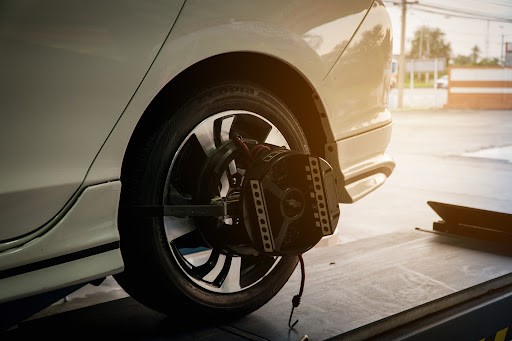
When it comes to keeping your ride running as silk, wheel alignment is the name of the game. But, how do you know when your wheels are playing tricks on you? Let’s go through a few telltale signs, as prepared by top experts in auto repair in Centennial, CO, that’ll let you know when it’s time to hightail it to the garage for a wheel alignment check.
Getting Your Wheels Aligned
Wheel alignment, or suspension alignment as some call it, is all about tweaking your vehicle suspension parts so that the wheels and the pavement are in perfect harmony.
Now, when your wheels are aligned just right, they’ll wear down in sync, giving you better control, saving gas, and enhancing the whole driving experience. This job usually involves adjusting three components, which are the toe, camber, and caster. Those terms correspond with the angles of the wheel and the steering axis. Getting these parts dialed in means a road trip that’ll be smooth and relaxing.
When To Get a Wheel Alignment
What signs should you look for to see if a wheel alignment is needed? There are certain clues to pay attention to that point out the presence of misaligned wheels. Wheels that need an alignment often display symptoms such as shakiness, irregular tire wear, slow or delayed steering, and instability in your vehicle. If you see or feel any of the indications mentioned below, then it’s time to head to your most trusted auto shop.
- Non-uniform Wearing of Tires
Spotting irregular tire wear on your car can signal poor wheel alignment. Ideally, all tires should show consistent wear and tear as you drive and should usually exhibit even levels of wear. If a noticeable difference in wear between tires is seen, this usually serves as a clear indication that the wheels are not aligned right.
Three usual uneven wear patterns that suggest your tires require alignment are:
- Camber wear – To notice camber wear, look at your tire edges. Sometimes, there will be a more pronounced level of wear on the inner or outer edges due to the wheels having an incorrect camber angle.
- Heel/toe wear – This form of wear features a jagged design around the tire’s edge with alternating high and low points resulting from improper tire rotations or toe adjustment settings.
- Feathering – Feathering wear is identified by one side of the tire being smooth and the other having a rough, sharp edge, and it is caused by a tire wearing down at an unnatural angle.
Addressing bad tire alignment issues as soon as possible better guarantees a safe and smooth driving experience and lengthens the life of your tires.
- Vehicle Pulling To One Side
A car pulling to one side on a flat, straight road, could mean your tires need to be aligned. Bad wheel alignment can make the tire pressure uneven, making your car drift left or right, even if you’re steering straight.
Your car might also lean to one side if your tires aren’t inflated right or the road is bumpy. To figure out if that’s the problem, drive on different roads and check your tire pressure. Keep in mind, some roads have a natural tilt that could make your car pull a bit.
Bad wheel alignment can be a small bother or a big safety risk, especially if you have to keep fixing your steering to drive straight. If you’re worried about your car pulling to one side, get your tires checked to see if they need an alignment so that potential accidents can be avoided.
- Steering Wheel Problems
If the steering wheel is bent to the left or right when driving straight, it might mean your car’s wheels aren’t lined up right. This means your wheels aren’t properly matched with each other and the road.
Stuff like hitting a curb or driving through a pothole can make your steering wheel go off-center. A wonky steering wheel can make driving tricky because it’s hard to know which way your car’s going, requiring extra effort to steer.
- Shaking Wheel
If your steering wheel shakes, your car might need an alignment. Shaky steering can come from incorrect tire pressure levels caused by misaligned wheels. This isn’t just annoying; it can also make it harder to control your car.
Ignoring a shaky steering wheel can lead to bad stuff, like using more gas, bad handling, and tires wearing out faster. Plus, it can stress out other parts of your car, which might break down
Sorting out steering wheel shakes is key for safe driving. If a mechanic finds out bad wheel alignment is the problem, they’ll fix the suspension components to stop the shakes and make your car handle better.
- Instability in Steering
Bad wheel alignment can make your car’s steering and handling worse. Along with the other symptoms of bad wheel alignment, if your wheels aren’t lined up right, your car might end up feeling wobbly and harder to control when turning or moving around
These problems can make it easier to lose control of your car, especially in emergencies or tricky driving situations. It’s important to fix these issues to keep you and your passengers safe.
The Bottom Line
Poor wheel alignment can cause a bunch of issues that mess with how comfy and easy it is to drive your car. Many problems can surface, like steering troubles and tires wearing out unevenly. It’s important to keep your tires lined up right to avoid extra wear on your car’s parts and to stay safe on the road.










